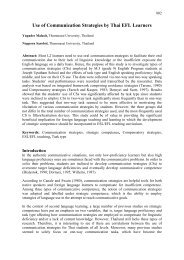The Effects of Semantic Mapping on Vocabulary Memorizing
The Effects of Semantic Mapping on Vocabulary Memorizing
The Effects of Semantic Mapping on Vocabulary Memorizing
Create successful ePaper yourself
Turn your PDF publications into a flip-book with our unique Google optimized e-Paper software.
that if the semantically related words are separated in the lists, adults tend to cluster them in<br />
output.<br />
Ward and Annita’s study (1998) showed that semantic mapping increased cognitive processing<br />
and developed the cognitive structure. <str<strong>on</strong>g>The</str<strong>on</strong>g>y suggested using semantic mapping as a pre-reading<br />
or pre-writing stimulus, or as a post-reading check <str<strong>on</strong>g>of</str<strong>on</strong>g> comprehensi<strong>on</strong>. <str<strong>on</strong>g>The</str<strong>on</strong>g>y c<strong>on</strong>cluded the<br />
ultimate goal <str<strong>on</strong>g>of</str<strong>on</strong>g> semantic mapping is to introduce the students to a technique that they could use<br />
regularly to organize what they had read, relate this c<strong>on</strong>tent to what they already know, and<br />
expand their store <str<strong>on</strong>g>of</str<strong>on</strong>g> knowledge through reading.<br />
Some researchers compared the effectiveness <str<strong>on</strong>g>of</str<strong>on</strong>g> semantic mapping with <str<strong>on</strong>g>of</str<strong>on</strong>g> other techniques.<br />
Pikula (1987) compared the effectiveness <str<strong>on</strong>g>of</str<strong>on</strong>g> the two techniques (semantic mapping and<br />
dicti<strong>on</strong>ary) for 38 students <str<strong>on</strong>g>of</str<strong>on</strong>g> experimental and c<strong>on</strong>trol groups. In his study, the experiment<br />
group developed the network <str<strong>on</strong>g>of</str<strong>on</strong>g> semantic categories using their existing knowledge <str<strong>on</strong>g>of</str<strong>on</strong>g><br />
vocabulary whereas the c<strong>on</strong>trol group used a dicti<strong>on</strong>ary to learn vocabulary. Posttest results at<br />
the end <str<strong>on</strong>g>of</str<strong>on</strong>g> the six-week period indicated statistically significant difference between the two<br />
groups. <str<strong>on</strong>g>The</str<strong>on</strong>g> experimental group exhibited a great enough gain over the c<strong>on</strong>trol sample.<br />
DeCarrico (2001) also c<strong>on</strong>ducted a research <strong>on</strong> semantic mapping. She made a decisi<strong>on</strong> that<br />
semantic mapping is an activity that helps bring into c<strong>on</strong>sciousness relati<strong>on</strong>ships am<strong>on</strong>g words in<br />
a text and helps deepen understanding by creating associative networks for words. A text is<br />
chosen based in the words to be learnt and students are asked to draw a diagram <str<strong>on</strong>g>of</str<strong>on</strong>g> the<br />
relati<strong>on</strong>ship between particular words found in the text. A variati<strong>on</strong> <strong>on</strong> this technique, a<br />
“vocabulary network” could be designed to help even beginning students learn to make semantic<br />
associati<strong>on</strong>s within a particular superordinate heading. She c<strong>on</strong>cluded that “especially at the<br />
beginning levels the teaching <str<strong>on</strong>g>of</str<strong>on</strong>g> words lists through words associati<strong>on</strong> techniques has proven to<br />
be successful way to learn a large number <str<strong>on</strong>g>of</str<strong>on</strong>g> words in a short period and retain them over time”<br />
(p.288-289).<br />
In their case studies, Margosein, Pascarella and Pflaum (1982) and Vogt (1983) c<strong>on</strong>firmed that<br />
semantic mapping has a greater impact <strong>on</strong> vocabulary acquisiti<strong>on</strong> than does the c<strong>on</strong>text clue<br />
approach or the traditi<strong>on</strong>al dicti<strong>on</strong>ary-definiti<strong>on</strong>-plus-example approach, because semantic<br />
mapping motivates the students to c<strong>on</strong>nect their prior knowledge to new words and to see the<br />
lexical or c<strong>on</strong>ceptual relati<strong>on</strong>ships am<strong>on</strong>g words.<br />
Some other researchers; however, took cauti<strong>on</strong> against the danger <str<strong>on</strong>g>of</str<strong>on</strong>g> presenting closely related<br />
new words. <str<strong>on</strong>g>The</str<strong>on</strong>g>y suggested that learners should start by learning semantically unrelated words<br />
(Tinkham, 1993; Waring, 1997) and also avoid learning words with similar forms (Laufer,<br />
1997). Nevertheless, after examining the research <str<strong>on</strong>g>of</str<strong>on</strong>g> Tinkham and Waring, Liu (?) believed that<br />
the research methodology itself quite puzzling. In their research, Tinkham and Waring had their<br />
participants learn new words paired with artificial n<strong>on</strong>sense words (e.g., pear—okess, mouse—<br />
kunop) simply by oral repetiti<strong>on</strong>. <str<strong>on</strong>g>The</str<strong>on</strong>g>n, they c<strong>on</strong>trasted the trials in which their participants<br />
learned semantically related words to the trials in which their participants learned unrelated<br />
words. Liu (?) also pointed out that Tinkham and Waring both made an incorrect c<strong>on</strong>clusi<strong>on</strong> that<br />
the participants learned more slowly when they were shown words in semantic clusters paired<br />
with artificial words.<br />
638






